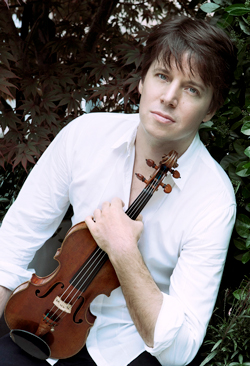by Daniel Hathaway
When
The crowd had to wait for the second half to enjoy Bell’s luminous performance of the 40-minute concerto, but what went before was anything but mere program filler. Jörg Widmann’s Lied [Song] and Béla Bartók’s Dance Suite offered exciting contributions all their own.
Widmann was the orchestra’s composer-in-residence from 2009-2011, but his homage to Schubert predates that appointment, having been commissioned by the Bamberg Symphony for performance in 2003 and re-premiered in a revised version by the BBC Symphony in 2010. In program notes, the composer offered a complicated explanation of what he originally intended (a monodic orchestra work where “all the instruments sing a kind of eternal melody without cease”) and how his concept of the 30-minute work changed in the course of composition to creating an expression of Schubert’s musical language, always “seeking” and “wandering.”
Many of us have had musical dreams where themes came to the foreground then, slippery as fish, went away again, leaving us with the impression that we had actually heard a melody we could remember after waking. Lied is like that —a phantasmagoria of Schubertian vocal fragments that dart in and out of various orchestral textures, beginning almost inaudibly and passing through hazy scenes decorated with interesting instrumental effects. Microtonal bending of lines in the strings and the unusual timbre of the accordion add to the fantastic soundscape. Eminently listenable thanks to its evanescent melodies, Lied still goes on a bit longer than necessary to make its point. The orchestra played it with extraordinary clarity.
Also full of melody but of an ethnic variety, Bartók’s 1923 Dance Suite ended the first half of the evening with a blaze of Hungarian rhythmic vitality. Incisive, festive and percussive, its five continuous movements explored shifting metric patterns and unusual pairings of solo instruments before culminating in a thrilling sixth movement finale. Welser-Möst and the orchestra made easy and brilliant work out of the suite’s obvious complexities.
Though Joshua Bell has now earned superstar status, he wears his celebrity lightly. When he touches his bow to the strings, it’s all about the music, which he addresses with complete seriousness of purpose. His gorgeous tone, even throughout its range, splendid intonation and impressive technical facility all figured hugely in last night’s performance. Not to mention his signature habit of weaving back and forth as he plays — something that might be annoying in a lesser artist but becomes strangely charismatic with this one.
Bell, Welser-Möst and the orchestra made an expressive team for an elegant and thoroughly classical performance of the Beethoven concerto, staying in close touch throughout. Ensemble was tight but replete with detail and nuance. Since Beethoven apparently wrote no cadenzas for opus 61, Bell played his own — highly violinistic yet tasteful and stylish flights of fancy that added a note of freshness to an otherwise well-known work. Throughout, Barrick Stees had important bassoon solos and played them wonderfully.
At the end of the rollicking Rondo, Joshua Bell was called back to the stage several times, acknowledging a lengthy ovation with winning humility. On the last few trips, he left his Strad backstage as if to signal to a crowd that might want to hear more that there might be nothing more left to say. After the Beethoven, there really wasn’t.
Photograph ©Roger Mastroianni, courtesy of The Cleveland Orchestra.
Click here to comment on this article. All comments will be moderated by the editorial staff.
Published on ClevelandClassical.com January 18, 2013
Click here for a printable version of this article.



